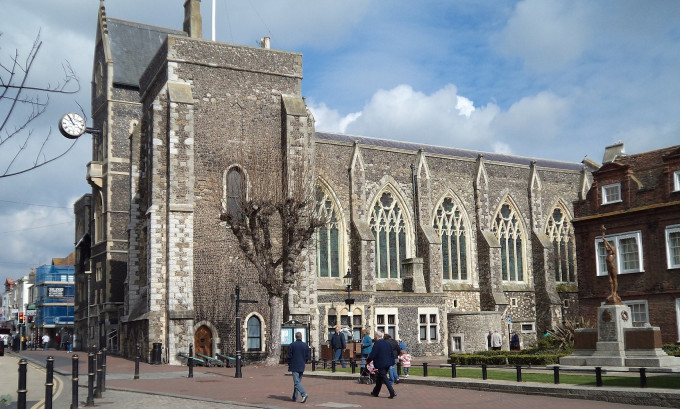It is worth noting that the end of this week and next will comprise numerous research meetings, including for the Lossenham Project and Medieval Animals Heritage, as well as notice of the winner of the Lawrence Lyle Masters Dissertation Prize. Moreover, 3 November will be the joint monthly FCAT lecture with CKHH, our speaker being Martin Crowther on ‘Reawakening a Gothic Fantasy‘, an exploration of Dover’s Maison Dieu, in Old Sessions at 7pm, visitors welcome with the usual conditions. However, for the blog this time I want to catch up on the last two Lunchtime Lectures and the Kent History Postgraduates meeting, plus note that the advisory committee of Dr Diane Heath’s NHLF-funded ‘Medieval Animals Heritage’ project met mid-week, as did that for the Kent Pilgrim Festival and that all but one of the CCCU Diamond Jubilee postgraduate exhibition posters on show last weekend during the Jubilee Conference were produced by members of the Kent History Postgraduates group, of which three featured Kent history and archaeology topics – see below. Additionally, I was fortunate that my second Festival walk last weekend didn’t suffer because of rain!
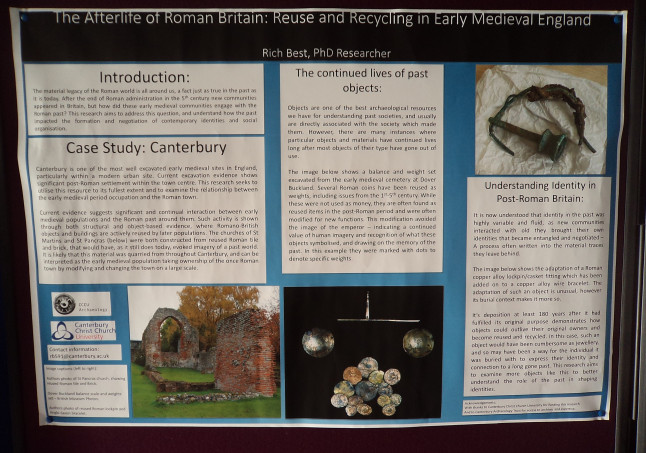
So to return to Dr Claire Bartram’s Canterbury Festival Lunchtime Lectures series, on Thursday we were in the university chapel for Dr Maria Diemling’s presentation on thinking about the ways Jewish communities can keep the memory of the Holocaust alive now that so few people who survived it are still living. The answer in part would seem to be through the role of cultural objects to offer ways to engage with past communities and the personal stories that can be commemorated by people today and in the future.
Thus, for the Jewish community at Ramsgate, it is their use of the Torah scrolls from Klatovy, a once flourishing Jewish community in the Czech Republic until most were deported in November and December 1942 never to return, that provides them with the connection to this crucial time in Jewish history. Maria provided her audience with a summary of how the scrolls got from Klatovy to Ramsgate and some details about the earlier community that used them, as well as how they had been restored when they came to England and how they were now used not just at Ramsgate, but that other Klatovy scrolls were held by several Jewish communities in the United States. Hence, this has also been a way of bringing present day Jewish communities together through their common bond to preserve this memory.
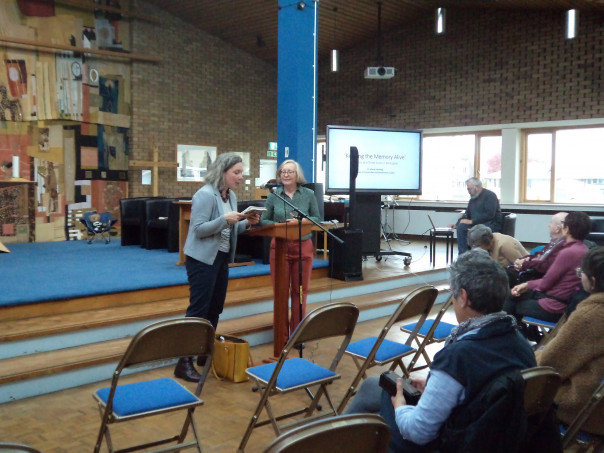
Maria next explored how Ramsgate was seeking to fulfil what they see as their duty to the people of Klatovy. This is being done by drawing on Marianne Hirsch’s idea of ‘postmemory’ through listening to stories and seeing images and objects to offer an imaginative active engagement, but not the idea of recollection because we can never understand what these people went through. Among the ways Ramsgate is doing this is its ‘tree of memory’ where the leaves are inscribed with the names of the murdered Jews from Klatovy – an almost constant reminder of these ‘lost’ individuals who have now become part of the Ramsgate community through the tree and the shared use of the Torah scrolls. Other activities have drawn in Christ Church students, such as interviewing people of the Holocaust Trust and an exhibition that again focuses on individuals. Nor is it just the adults who are remembered for there has been a major effort to link individual children across time whereby there will be at least one person who will keep the memory of that murdered child alive.
All these efforts have not solely been within the Ramsgate Jewish community but have extended to local schools, thereby making this an interfaith initiative. Photos of victims have been a very useful way of engaging with people, as has the importance of people’s names. As Maria said, the Ramsgate community intend to have a website with all of this information and the level of interest in the project was obvious from the number and type of questions that followed Maria’s presentation.
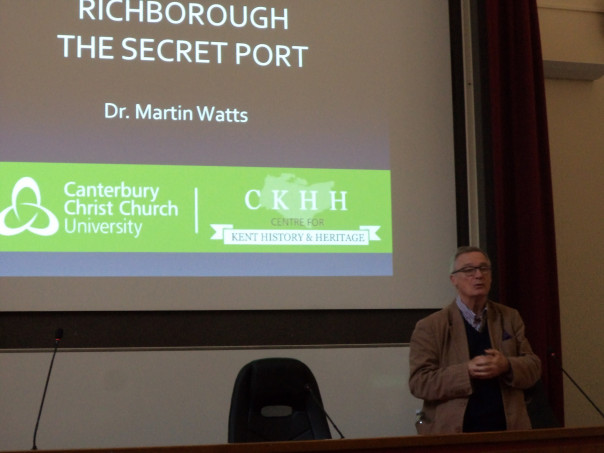
So to Friday and Dr Martin Watts took the audience back in time to the First World War and how the port of Richborough was revived for a government initiative in 1917 whereby the Allies sought initially to bolster the defence of Amiens. Martin provided some background to the need for this massive logistical operation and how this was one of those crucial periods when the outcome hung on a knife edge. For it had got to the stage where there was no spare capacity at the usual ports of Folkestone and Southampton, and thus another port was needed that had extensive capacity. Furthermore, Richborough was to be a closely guarded secret, not only from the Germans but from the command structure of the British Army, the port being a War Office operation.
For the people of east Kent and further afield it provided welcome jobs, training in the form of apprenticeships and a major boost to the local economy, not least because of the supplies needed to keep the port’s community fed and accommodated. The speed with which this port was constructed was phenomenal, but then it needed to be and at first transport across the Channel was on great barges towed across to France. However, it was the creation of the Ro-Ro (roll-on – roll-off) ferries that was the revolutionary development, and three of these were built in a matter of months, thereby massively speeding up the turnaround time of loading and unloading because railway stock, as well as motor traffic, could be driven off and on at the quey side. Not that everything was always straightforward, and the deal was that while men were part of the Royal Engineers, they were able to negotiate their pay and conditions.
Martin discussed the command structure and how Col. Briggs was tasked with compiling a report on how and what had been going on. At the same time, this was a period of very heavy casualties among the Allied forces, but because of the mood of the country it was accepted. Indeed, Briggs was about to give his confidential report when the War Office had him transferred to Ireland. Moreover, 1919 was the port’s busiest period, with the idea that there should be a 10-year transition period keeping the railway running. Nevertheless, the port was put up for sale in December 1919 but didn’t find a sensible buyer. Two of the Ro-Ro ferries had reasonably long lives post WWI, the TF1 going on for 40 years before being scrapped in 1957. Like all the talks, this too brought questions from the audience and Claire is to be congratulated for bringing together this fascinating series.
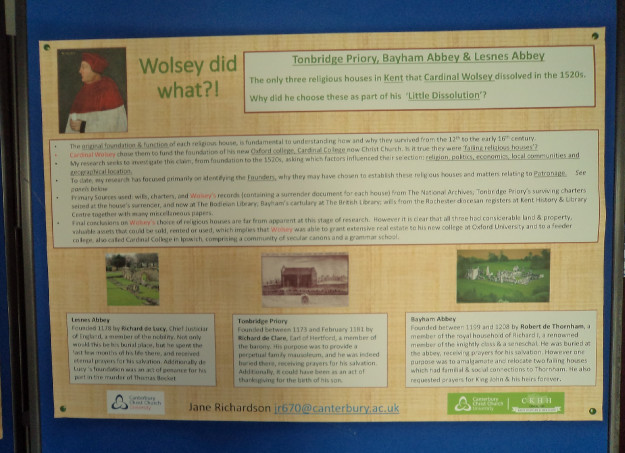
Turning now to the Kent History Postgraduates meeting, numbers were smaller than sometimes, a reflection of matters such as half-term and that some are at a crucial point in their work and are thus exceedingly busy. As with our usual practice, we went round the group and Jason started by telling us about his project because having only just started this was his first meeting. He began by giving a bit of background information before explaining the provisional title of his thesis and the research questions he hopes to address. Looking at how he intends to do this, he wants to analyse discourse and transgression by exploring the lived experiences of those in the Cinque Ports for the period c.1600-c.1640. He is interested in behaviour, power and habitus, including how such factors came into play within the vertical and horizontal networks and ties within these societies. Consequently, he hopes to investigate both high and low discourses within what was a very hierarchical society, and how these different voices can be ‘heard’ within the archives. Currently, he believes Faversham and Dover will offer suitable cases studies, but his first priority is to gain a clear understanding of the period more broadly, as well as explore the particularities of Kent and see how others have deployed the types of evidence he thinks will be his primary sources.
This generated several comments, including how his project fits into the funded project on ‘Kent’s maritime communities’ involving CCCU and the University of Southampton, and having commented on that we moved onto Kieron who is the other doctoral student allied to the project. She, too, is using Dover for her case study but for the 16th century because she is exploring the role and place of the Maison Dieu in the early modern development of Dover, especially regarding its role as the royal victualling yard, and its connection to the various new harbour works under the Tudors. For by placing the Maison Dieu at the centre of her analysis, Kieron hopes to explore town-Crown relations, as well as vertical and horizontal networks within Dover and beyond that had implications for how the town was governed, who were the governors and governed, and how such ties relate to those outside the town itself. There will be more from Kieron next time once she has done the next KHP presentation.

Moving on to Janet, she explained that she is coming to the end of her PhD project but because of certain medical problems, she is seeking an extension. For those new members, Janet explained that she is investigating the hundred of Ruxley in north-west Kent because she is interested in the development of the manor of Scadbury and the implications of Christ Church Priory’s manorial holding at Orpington, and how they affected the local society 1200-1350. As Janet said, her choice of period was partly driven by the survival of a detailed lay subsidy return for 1301 having material on the moveable goods belonging to householders in the hundred. One of her questions relates to the presence and activities of Londoners and the implications of such relations horizontally and vertically.
As you can see there are common themes and approaches, even allowing for the very different time periods and this is similarly the case for Jane’s topic, the three west Kent religious houses that were dissolved by Cardinal Wolsey among the 29 he employed to establish his college at Oxford and a feeder college at Ipswich. Indeed, this has similarities to Archbishop Thomas Rotherham in the blog a couple of weeks ago. Because Jane is covering a long period – 12th century to 16th century – she is using a snapshot approach of foundation, the difficult 14th century, and final era both before and after surrender, and for each using common themes to link the three periods. She has done more on Tonbridge thus far but needs to get to The National Archives shortly to look at the Lesnes Abbey documentary sources.
Like Jane, Grace had produced a poster for the Jubilee exhibition which illustrates how she is assessing coastal community archaeological projects and the groups involved. In particular, at the moment she is considering matters around legacy, especially issues relating to longevity and sustainability for impacts and outputs. In other words, one of her key questions is what have people got out of the project while they were actually doing it, and did this go beyond their active engagement. One of the projects she has been assessing is that concerning the archaeology of post-medieval fish traps at Sandwich. She has found that volunteers became involved in part because they were able to link to the natural environment.
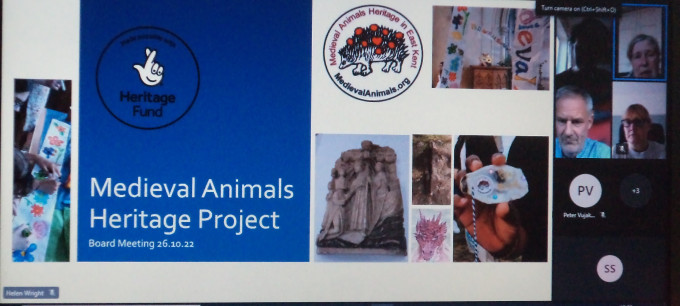
This is not the same for the Dover White Cliffs project that focuses on the WWII batteries and this group of military enthusiasts are seeming motivated by the martial aspect of the finds, not the natural environment, thus Grace is thinking this will mean her groups are site specific. This generated discussion, and because of Janet’s experience at Scadbury, she will meet up with Grace to discuss the topic.
The final person was Peter who is recovering from Covid. This has made concentrating very difficult so he instead talked about his highly successful Medway History day at Gillingham and for that please see this report: https://blogs.canterbury.ac.uk/kenthistory/canterbury-and-medway-bringing-history-alive-in-kent/ Among those exhibiting at Gillingham was Diane and her ‘Medieval Animals Heritage’, and this was one of the many events that featured in her report to the advisory committee. Indeed, this project continues to be highly successful in its aim to aid SEND children and their families through engaging with animals, so please watch this space for future events.
 Centre for Kent History and Heritage
Centre for Kent History and Heritage Sheila Sweetinburgh
Sheila Sweetinburgh 1212
1212